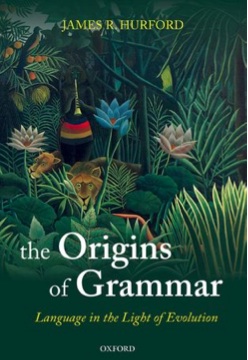
(See reviews of The Origins of Grammar here.)
Interview with Chris Cummins about The Origins of Grammar on the New Books in Language website.
 |
One volume in three parts (2011) Oxford
University Press (UK), and (2012) Oxford University Press (USA). (See reviews of The Origins of Grammar here.) Interview with Chris Cummins about The Origins of Grammar on the New Books in Language website. |
 1.1.1 Bees and ants evolve simple innate
compositional systems
1.1.1 Bees and ants evolve simple innate
compositional systems  1.1.2 Combining territorial and sexual messages
1.1.2 Combining territorial and sexual messages
 1.1.3 Combinatorial, but not compositional, monkey
and bird calls
1.1.3 Combinatorial, but not compositional, monkey
and bird calls  1.3.1 Simplest syntax: birdsong examples
1.3.1 Simplest syntax: birdsong examples  1.3.2 Iteration, competence, performance and
numbers
1.3.2 Iteration, competence, performance and
numbers  1.3.3 Hierarchically structured behaviour
1.3.3 Hierarchically structured behaviour  1.3.4 Overt behaviour and neural mechanisms
1.3.4 Overt behaviour and neural mechanisms  1.3.5 Training animals on syntactic `languages'
1.3.5 Training animals on syntactic `languages'
 2.1.1 Monkey-ape-human brain data
2.1.1 Monkey-ape-human brain data  2.1.2 Manual gesture and lateralization
2.1.2 Manual gesture and lateralization  2.1.3 Fitness out of the here and now
2.1.3 Fitness out of the here and now  2.2.1 Synaesthetic sound symbolism
2.2.1 Synaesthetic sound symbolism  2.2.2 Conventional sound symbolism
2.2.2 Conventional sound symbolism  3.5.1 Regular production
3.5.1 Regular production  3.5.2 Intuition
3.5.2 Intuition  3.5.3 Gradience
3.5.3 Gradience  3.5.4 Working memory
3.5.4 Working memory  4.4.1 Distributional criteria and the proliferation
of categories
4.4.1 Distributional criteria and the proliferation
of categories  4.4.2 Categories are primitive, too -- contra
radicalism
4.4.2 Categories are primitive, too -- contra
radicalism  4.4.3 Multiple default inheritance hierarchies
4.4.3 Multiple default inheritance hierarchies
 4.4.4 Features
4.4.4 Features  4.4.5 Phrasal categories are unnecessary
4.4.5 Phrasal categories are unnecessary  4.4.6 Functional categories -- grammatical words
4.4.6 Functional categories -- grammatical words
 4.4.7 Neural correlates of syntactic categories
4.4.7 Neural correlates of syntactic categories
 5.6.1 Identifying creoles and pidgins
5.6.1 Identifying creoles and pidgins  5.6.2 Substrates and superstrates
5.6.2 Substrates and superstrates  5.6.3 Properties of pidgins and creoles
5.6.3 Properties of pidgins and creoles  5.8.1 Nicaraguan Sign Language
5.8.1 Nicaraguan Sign Language  5.8.2 Al-Sayyid Bedouin Sign Language
5.8.2 Al-Sayyid Bedouin Sign Language  5.9.1 Shared knowledge and a less autonomous code
5.9.1 Shared knowledge and a less autonomous code
 5.9.2 Child and adult learning and morphological
complexity
5.9.2 Child and adult learning and morphological
complexity  5.9.3 Historico-geographic influences on languages
5.9.3 Historico-geographic influences on languages
 6.5.1 Kanzi doesn't get NP coordinations
6.5.1 Kanzi doesn't get NP coordinations  6.5.2 Hierarchical structure in non-linguistic
activities
6.5.2 Hierarchical structure in non-linguistic
activities  6.5.3 Hierarchical structure in the thoughts
expressed
6.5.3 Hierarchical structure in the thoughts
expressed  6.8.1 Constructions and plans for action
6.8.1 Constructions and plans for action  6.8.2 Syntax, navigation and space
6.8.2 Syntax, navigation and space  7.4.1 Relaxation of constraints
7.4.1 Relaxation of constraints  7.4.2 Niche construction and positive selection
7.4.2 Niche construction and positive selection
 7.4.3 Metarepresentation and semantic Ascent
7.4.3 Metarepresentation and semantic Ascent